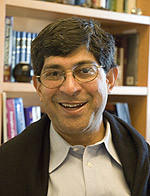Berkeleyan
A building with its own fan club
![]()
03 October 2007
The Berkeleyan wandered through Stanley Hall one day last week, asking everyone we met how working in the new building was likely to make a difference in their work. Not a few said it already had...
Amy Herr
Assistant Professor, Bioengineering
I'm a new faculty member in the Department of Bioengineering, and the opportunity to house a research lab in an environment as unique in its mission as Stanley Hall was a compelling reason for me to move to Berkeley. Research in my group focuses on exploiting scale-dependent phenomena to further quantitative biology. Stanley Hall cultivates interactions - both purposeful and unexpected - that critically benefit our work. I see it as more than a fantastic structure on Berkeley's campus - I believe it embodies a new paradigm of biophysical-science research.
 |
Associate Professor, Bioengineering and QB3; Faculty Scientist, LBNL
One useful thing about the building simply is proximity to other people doing exciting quantitative work. Things happen by chance; things happen based on conversations you have while walking down a hall, and that can't happen unless there's somewhere for that to take place. That kind of environment has been missing for people from different disciplines trying to do work on biological systems, and this building really fills that niche.
Theresa Ulrich
Graduate Student, Bioengineering
My group, which primarily studies the mechanobiology of cancers and stem cells in the nervous system, occupied temporary space in the civil engineering building until moving to the new Stanley Hall this summer. In addition to offering beautiful new facilities, Stanley has created the sense of community we were missing in our temporary lab space. It's been wonderful for us to move to a building where we can be together with the bioengineering department and enjoy an interdisciplinary, collaborative environment. We've already begun facilitating the sharing of equipment, reagents, and ideas with neighboring groups sharing similar research interests.
 |
Roseanne Wicek
Graduate Student, Biophysics
When you're working on a problem, you can get focused so narrowly that you miss the big picture. But in this building, when you run into your friend in the hallway and chat with him about it, you see that he's looking at your problem from a different standpoint. Maybe he can point out something simple that you didn't notice, because you're missing the forest for the trees.
Kyle Kurpinski
Doctoral Candidate, UCSF/UCB Joint Graduate Group in Bioengineering
The new Stanley Hall offers countless research opportunities for faculty, grad students, and undergrads alike. Particularly for our lab, the move from our old facility at the Richmond Field Station to our new space on campus has opened a lot of doors. For one thing, the new facilities are far nicer than what we had off-campus.
Daniel Guerra
Postdoctoral Researcher, Biophysics
I feel closer to my colleagues since we've been in this building. We see each other more than before and talk much more with each other. It has definitely improved the exchange of ideas with my direct colleagues.
 |
Ross Rounsevell
Postdoctoral Researcher, Bioengineering
There's something I found coming to Berkeley from the U.K. - people really want to exchange ideas and information here. This building picks up on that general campuswide ethos but makes it even more immediate. I feel I can go anywhere in the building and speak to anybody. You start a conversation and talk to people about how to do things, get access to equipment, and before you know it you might start a new collaboration between two groups that would never have spoken to each other before.
 |
John Kuriyan
Chancellor's Professor of Molecular and Cell Biology; Investigator, Howard Hughes Medical Institute
I think the tendency to interact with people falls off quite sharply with distance. Even buildings that are next door to each other but involve you crossing a courtyard will reduce the chance of interacting with somebody. The whole idea of bringing people from different disciplines into the same arena - which, while it seems obvious, is rarely implemented in other buildings - is already having unexpected consequences for me in terms of the people that I talk to. The size of this building and the number of people it's brought together has made a remarkable difference that way.
Pamela Reynolds
Communications Manager, Bioengineering
One of the most significant improvements is in service to our undergrads. We formerly lacked a teaching laboratory on campus for our important bioengineering lab courses. They were taught in a lab at the Richmond Field Station, a long bus ride away. We now have a state-of-the art teaching lab in B144, the Cell Biology and Biotechnology Teaching Lab, and another teaching lab being designed for the Bio-Nano Technology Center in Stanley. Enrollment in our lab courses is strong this semester, and faculty are busy designing more courses to take advantage of the facilities.
Mike Rosenbluth
Doctoral Candidate, UCSF/UCB Joint Graduate Group in Bioengineering
Stanley Hall has been a fantastic improvement for my research and the Fletcher Lab's research as a whole. Our research involves measurement of biological processes on the nanoscale level, and our new temperature-controlled, vibration-isolated instrument rooms have increased the sensitivity of our experiments. It is also great to have all the infrastructure we need to do our research in the building - liquid-nitrogen supplies, autoclaves, ice machines - all steps from our lab. Lastly, it has been key to finally have a place that bioengineering can call home. And the view of the bay from my desk window can't be beat!
Wendy Edelstein photos

